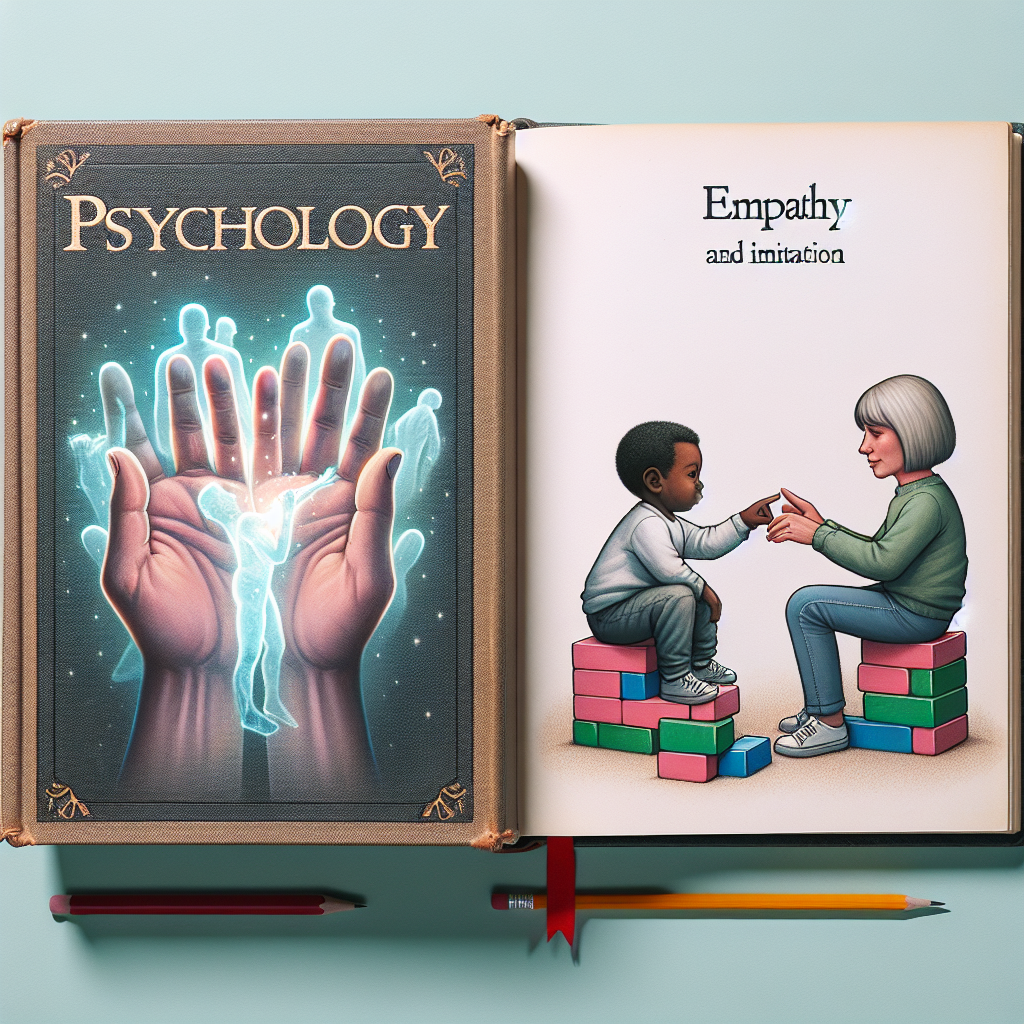
Empathy and Imitation: The Ultimate Foundations of Social Learning in Behavioral Psychology
Introduction
In an increasingly interconnected world, the ability to understand and relate to others has never been more essential. Understanding the nuances of human behavior is pivotal in fields ranging from education and therapy to business and leadership. At the core of these interactions lies a profound truth: empathy and imitation are the foundations of social learning in behavioral psychology. These two powerful processes not only shape our individual identities but also influence the collective behavior of groups and societies.
Imagine a child learning to speak by mimicking their parents or a manager navigating team dynamics by intuitively understanding the emotions of their team members. Such scenarios illustrate how empathy and imitation serve as vital mechanisms through which we learn and adapt. In this article, we will explore the intricate relationship between empathy and imitation, and how together they underpin social learning—a concept that holds transformative potential for individuals and communities alike.
Theoretical Foundations of Social Learning
Understanding Social Learning Theory
Social Learning Theory, developed by Albert Bandura in the 1960s, posits that learning occurs in a social context and can happen through observation or direct instruction. Central to this theory is the idea of modeling, where individuals learn behaviors by observing others. Bandura’s famous Bobo Doll experiment demonstrated that children exposed to aggressive behavior modeled by adults were likely to imitate that behavior themselves. This underscores the necessity of both empathy and imitation in understanding social learning.
The Role of Empathy in Learning
Empathy involves the capacity to recognize and understand others’ emotions and perspectives. This emotional resonance facilitates deeper connections and more meaningful learning experiences. For instance, when educators express empathy towards their students, they create a supportive environment that enhances learning outcomes. Students are more likely to engage with the material and replicate the behaviors modeled by their empathetic teachers.
Empathy is not just a soft skill; it serves as a critical cognitive tool for social learning. By understanding another person’s emotional state, we can adjust our responses and actions accordingly. This adaptability is particularly crucial in collaborative settings, where communication and cooperation are key to success.
Imitation: A Fundamental Learning Mechanism
Imitation goes hand-in-hand with empathy as a fundamental learning mechanism. From a young age, we engage in imitation to acquire new skills, social norms, and even moral values. Children learn not only from direct instruction but also from observing their peers and adults in their environment.
Imitation serves as a bridge between observation and action. When a child sees a sibling sharing a toy, they may imitate that behavior, integrating it into their own repertoire of social skills. This phenomenon highlights how imitation is shaped by social context and emotional understanding, solidifying empathy and imitation as the cornerstones of social learning.
Case Studies Illustrating Empathy and Imitation in Action
Case Study 1: The Impact of Empathetic Leadership
Background: A tech startup faced high employee turnover and poor morale. The CEO recognized that fostering a more empathetic workplace could enhance employee satisfaction and retention.
Intervention: The CEO implemented a series of initiatives focused on empathy training, including workshops and team-building exercises that emphasized open communication and emotional awareness.
Outcome: Over six months, the company saw a 30% reduction in turnover rates and a notable increase in employee engagement scores. Employees reported feeling more understood and valued, translating to improved performance and collaboration.
Analysis: This case underscores how empathetic leadership can foster a positive work culture, demonstrating that empathy enriches the social learning environment within organizations.
Case Study 2: Learning Through Imitation in Early Childhood Education
Background: A preschool aimed to improve social skills among children aged 3-5, particularly in sharing and teamwork.
Intervention: The educators incorporated role-play and group activities in their curriculum, allowing children to observe and imitate their peers’ behaviors, with a particular emphasis on empathetic responses to others’ needs.
Outcome: Observational assessments indicated a significant increase in sharing behaviors and cooperative play among the children over one school year.
Analysis: This case illustrates that through structured opportunities for imitation and empathy, educators can effectively enhance social learning in young children, reinforcing the critical role these processes play in early development.
The Cognitive Benefits of Empathy and Imitation
Enhancing Social Cognition
Empathy and imitation work synergistically to enhance social cognition—the mental processes involved in understanding and interacting with others. Studies have shown that individuals with high empathy are more adept at reading social cues, navigating complex social situations, and developing stronger interpersonal relationships.
Fostering Emotional Intelligence
The interplay between empathy and imitation also fosters emotional intelligence (EQ). Emotional intelligence is the ability to perceive, control, and evaluate emotions, and it is crucial for effective communication and conflict resolution. Individuals with higher EQ tend to excel in collaborative environments, lead teams effectively, and maintain positive relationships.
Incorporating empathy and imitation into educational and professional development programs can thus equip individuals with the emotional skills necessary for thriving in socially complex contexts.
Empathy and Imitation in Practice
Practical Strategies for Individuals
Cultivate Active Listening: Practice being fully present in conversations, reflecting on others’ feelings and perspectives.
Model Desired Behaviors: Whether in a classroom or workplace, demonstrate the behaviors that embody empathy and collaboration, allowing others to imitate you.
- Engage in Reflective Practice: After social interactions, reflect on what went well and what could be improved in your empathetic responses and actions.
Practical Strategies for Organizations
Empathy Training Programs: Integrate training that focuses on developing empathy among employees, with exercises designed specifically for team dynamics and communication.
Create Collaborative Environments: Design spaces and activities that encourage collaboration and peer learning, reinforcing imitation of positive behaviors.
- Encourage Feedback Culture: Foster an environment where employees can share their feelings and experiences openly, promoting empathetic listening and response.
The Future of Social Learning: Integrating Technology
The Role of Digital Platforms
As technology continues to evolve, so does the landscape of social learning. Digital platforms have the potential to enhance empathy and imitation through virtual learning environments. For instance, online simulations and role-playing games can provide learners with opportunities to practice empathetic interactions and model desired behaviors in a safe and controlled environment.
The Promise of Artificial Intelligence
Artificial Intelligence (AI) can also facilitate social learning by offering personalized learning experiences. For example, AI-driven platforms can analyze users’ social interactions, providing them with immediate feedback on their empathetic responses and suggesting ways to improve their social skills.
Ethical Considerations
While technology presents exciting opportunities for enhancing empathy and imitation in social learning, ethical considerations must guide these developments. Ensuring that technology fosters genuine empathetic connections rather than superficial interactions is paramount. A focus on human skills in conjunction with technological advancements will be critical in maintaining the integrity of social learning processes.
Conclusion
In the grand tapestry of human interaction, empathy and imitation emerge as foundational threads that shape our social fabric. By understanding and embracing these elements, we can enhance social learning across different contexts, from education to professional settings. As we cultivate empathetic environments and model positive behaviors, we not only enrich our own lives but also the lives of those around us.
To foster meaningful connections and collaborative societies, we must commit to developing our empathetic abilities and encouraging others to imitate constructive behaviors. As we move forward in an increasingly complex world, let us remember that empathy and imitation are not merely psychological constructs; they are powerful tools for building a better future together.
FAQs
1. What is the relationship between empathy and imitation in social learning?
Empathy allows individuals to understand and connect with the emotions of others, while imitation enables them to replicate behaviors observed in others. Together, these processes enhance social learning and facilitate the acquisition of social skills and norms.
2. How can empathy be developed in educational settings?
Empathy can be developed through structured programs that promote active listening, perspective-taking, and emotional awareness. Role-playing and group activities can offer valuable opportunities for students to practice empathetic interactions.
3. What impact does empathetic leadership have on organizations?
Empathetic leadership fosters a supportive work culture, leading to improved employee morale, reduced turnover rates, and enhanced team collaboration. Leaders who model empathy inspire their teams to exhibit similar behaviors, creating a positive feedback loop.
4. Can technology aid in developing empathy?
Yes, technology can aid in developing empathy through virtual simulations that mimic real-life interactions, allowing individuals to practice empathetic responses in a controlled environment. AI can also provide feedback on social interactions, promoting reflection and improvement.
5. How does emotional intelligence relate to empathy and imitation?
Emotional intelligence encompasses the ability to understand and manage emotions in oneself and others. High emotional intelligence is often a result of strong empathy and imitation skills, as individuals with high EQ can better navigate social situations and foster positive relationships.
By exploring the interplay between empathy and imitation, we unlock new possibilities for enhancing social learning in behavioral psychology. Let us embrace these foundational elements as we strive to create a more compassionate and connected world.













